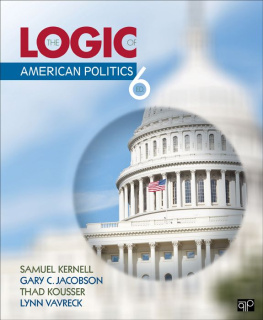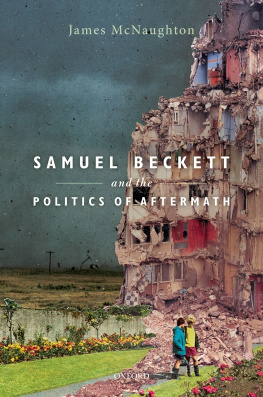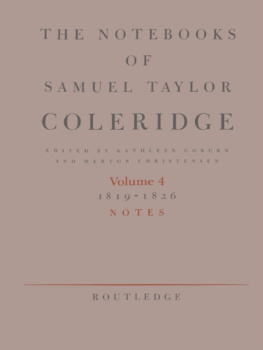
STUDENTS, GET THE MOST OUT OF LOGIC!

Use your smartphone or tablet to scan the QR codes in every chapter. Theyll take you to interesting video clips, political ads, speeches, interactive graphics, and more. (No smartphone? No problem. You can access all of these resources at logic.cqpress.com .)
If you dont already have a QR code scanner on your phone or tablet, do a quick search from iPhones Apple App Store or Androids Google Play to download a free app. Hover the phones viewer over a QR code and it will activate the following:
Watch a Video: Watch the books concepts and issues play out in the real world, from a British game show clip to political candidates in debate.
Interactive Map: Explore current trends in state marijuana laws, same-sex marriage, and more.
Take a Survey: Weigh in on issues like gun control and see how your answers compare with those of your peers.
Data Update: See how public approval of Congress and presidential popularity changes from month to month.
Read More: Read recent Supreme Court rulings or deals struck in Congress, well after the book has gone to press.
Take a Quiz: Test your knowledge of each chapter with this mobile-friendly study aid.
Want an A on the Exam?
Check out the open-access student study site ( logic.cqpress.com ) for chapter summaries, review questions, interactive quizzes, and eflashcards that will help you prepare for exams.
 WATCH A VIDEO
WATCH A VIDEO

logic.cqpress.com
See how the British game show Golden Balls uses the prisoners dilemma.
 INTERACTIVE MAP
INTERACTIVE MAP

logic.cqpress.com
See the effects of party control on vote and seat shares in the fifty states.
 TAKE A SURVEY
TAKE A SURVEY

logic.cqpress.com
Should gun control policy be decided in state capitols or in Washington, DC?
 DATA UPDATE
DATA UPDATE

logic.cqpress.com
View the most recent numbers on public approval of Congress.
 READ MORE
READ MORE

logic.cqpress.com
Review the complete nine principles of journalism.
 TAKE A QUIZ
TAKE A QUIZ

logic.cqpress.com
Test your knowledge of this chapter.

Three branches of government, two main political parties, thousands of interest groups, millions of voters, and countless media voices can make a confusing jumble out of American politics. Make sense of it all with The Logic of American Politics.
Kernell, Jacobson, Kousser, and Vavreck arm students with the tools they need for understanding institutional design concepts, building their critical thinking skills so they can see that there really is a logic to how the American political system works. Through 15 chapters, Logic explores the rules of the game and the way institutions structure the actions and choices of citizens and politicians. Students move beyond trying to memorize details and instead come away with the more lasting and crucial knowledge of why the American political system functions the way it does.

Take a look at the features that provide the framework to understanding American politics.
Chapter-opening vignettes draw in students while effectively pointing to a chapters main themes.
Blue text highlights passages that apply collective action and institutional design themes, helping to reinforce analytic points.

A set of feature boxes strengthen and extend the books analytic approach:
Logic of Politics boxes examine the design of various political institutions in light of the objectives they were intended to achieve.
Strategy and Choice boxes show how officeholders and those seeking to influence them employ institutions to advance their goals.
Politics to Policy boxes highlight how public policies reflect the institutions that produce them and evaluate institutional capacity to solve the nations problems.

I think the analytic framework is well developed throughout the book and is precisely why I assign Logic every semester. I always think that these analytical themes are best introduced in each chapter using short anecdotal stories (especially recent history) and the book is successful in this regard.
Paul Wohlfarth, University of Maryland
Key terms and suggested reading lists provide an easy way to review and study or explore additional resources for research and writing projects.
Students seize on the collective action and institutions framework and use it in their discussion and writing in the class. This is an indication to me that the book pays off for them.
Scott Meinke, Bucknell University
Exciting new changes in the sixth edition !
New coauthor Lynn Vavreck, draws on her research and expertise to bring a fresh dimension to the public opinion and media chapters.
A new full-color interior, clean and elegant in design, showcases more than 200 carefully chosen photographs and enhances the display of data in the books many maps, tables, and figures
Fully updated for recent events and new scholarship the sixth edition reflects the latest developments from landmark Supreme Court rulings to the impact of the 2012 election and the continuing impact of polarization.


Next page











![Samuel Beckett [Samuel Beckett] - The Complete Dramatic Works](/uploads/posts/book/72751/thumbs/samuel-beckett-samuel-beckett-the-complete.jpg)



 WATCH A VIDEO
WATCH A VIDEO










